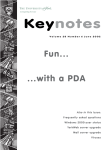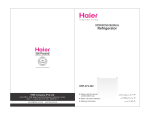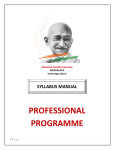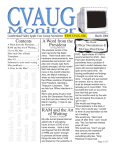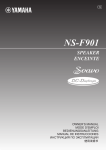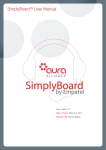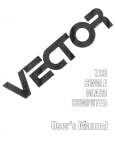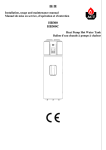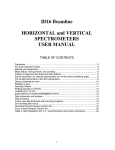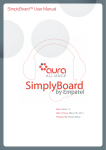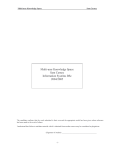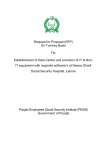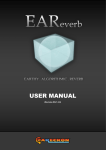Download Course Outline DIT (Revised 2012)
Transcript
GOVERNMENT OF THE PUNJAB TECHNICAL EDUCATION & VOCATIONAL TRAINING AUTHORITY CURRICULUM FOR Diploma in Information Technology (1-Year course) (Revised 2012) CURRICULUM SECTION ACADEMICS DEPARTMENT 96-H, GULBERG-II, LAHORE Ph # 042-09263055-9, 99263064 [email protected], [email protected] Diploma in Information Technology (1-Year Course) 1 TRAINING OBJECTIVES: The Course aims to producing the trained man-power in the field of Information Technology to fulfill employment requirement of I.T. industry not only in the country, but also abroad. The curriculum is divided into two academic semesters The curriculum of Semester-I is designed to train the students to work as database developer and work on the MS-office alongwith touch of E-Commerce. The curriculum of semester-II is designed to train the students in the field of Networking, Graphics Design & Animation and Interactive web development. CURRICULUM SALIENTS:- Name of Course: Diploma in Information Technology Entry Level: Intermediate or Equivalent. Duration: One Year The course consist of Two Semesters with 20 weeks of teaching delivery duration each Total Training Hours: 1600 Hours (800 hours per Semester) Training Hours: 40 Hours/week 7 Hours per day (Friday 05 Hours) Training Methodology: Practical 80% Theory Medium of Training 20% Urdu / English D e v e l o p e d b y C u r r i c u l u m S e c t i o n , A c a d e m i c s D e p a r t me n t TE V T A. Diploma in Information Technology (1-Year Course) 2 SKILL PROFICIENCY DETAILS On successful completion of this course, the trainee should be able to: 1. Work on different operating systems like DOS, Windows 7 & Linux. 2. Work on different Business applications (MS-Word. 2010, MS-Excel 2010 & MS – Power Point 2010) 3. Exercise Business Communication Skills & Report writing. 4. Develop and Manage Database Management System. 5. Apply and Analyze E-Commerce issues. 6. Design, Develop and manage interactive Web sites. 7. Develop Financial Accounting related issues in E- Commerce/Desktop applications and integrate them in different projects. 8. Host and upgrade the Web sites. D e v e l o p e d b y C u r r i c u l u m S e c t i o n , A c a d e m i c s D e p a r t me n t TE V T A. Diploma in Information Technology (1-Year Course) 3 KNOWLEDGE PROFICIENCY DETAILS On successful completion of this course, the trainee should be able to understand, define and recognize:- 1. EDP concept 2. Different operating systems (DOS, Windows, Linux). 3. Internet, Word processing, Spread Sheet and Multimedia presentation. 4. Business communication issues inside/out side the organization and report writing. 5. Database Concepts and requirements with MS-Access. 6. Programming logic using flowchart and developing front-end using VB.Net 7. System Analysis and Design. 8. Web Designing and Development 9. Web Programming with HTML and Java Script 10. Interactive Web programming using PHP, MySql & Apache Web Server. 11. Host and upgrade the Web sites. D e v e l o p e d b y C u r r i c u l u m S e c t i o n , A c a d e m i c s D e p a r t me n t TE V T A. Diploma in Information Technology (1-Year Course) 4 CURRICULUM DELIVERY STRUCTURE 1st SEMESTER Week Course Co-Curricular Project Test delivery activities/vacations 1 – 20 21 – 23 - - 20 3 0 1 Total 26 2nd SEMESTER Week Course Co-Curricular Project Test delivery activities/vacations 1 – 20 21 – 23 - - 20 01 04 1 Total 26 D e v e l o p e d b y C u r r i c u l u m S e c t i o n , A c a d e m i c s D e p a r t me n t TE V T A. Diploma in Information Technology (1-Year Course) 5 SCHEME OF STUDIES Diploma in Information Technology (01 Year) SEMESTER – 01 Sr. Main Topics No Theory Practical Total Hrs. Hrs. Hrs. 20 120 140 40 240 280 20 80 100 40 180 220 5 Introduction to Computer & Operating System (DOS, Windows & Linux) Business Application (MS-Word, MS-Excel, MS-Power Point 2010),Internet Management & E-Commerce Database Management using MS-Access 2010 Programming Fundamentals, Flow Charts and Programming with VB. Net. Functional English-I 20 20 40 6 Work Ethics-I 20 - 20 160 640 800 1 2 3 4 Total SEMESTER – 02 Sr.# Main Topics Theory Practical Total Hours Hours Hours 1 Graphics Design & Animation 20 180 200 2 System Analysis & Design 20 20 40 3 Introduction to Computer Networking 20 120 140 4 Web Development using PHP & My SQL. 60 240 280 5 Project - 60 60 6 Functional English-II 20 20 40 7 Work Ethics-II 20 - 20 160 640 800 Total D e v e l o p e d b y C u r r i c u l u m S e c t i o n , A c a d e m i c s D e p a r t me n t TE V T A. Diploma in Information Technology (1-Year Course) 6 DETAIL OF COURSE CONTENTS Diploma in Information Technology (01 –Year Course) Semester-I Sr. # Detail of Topic Theory Practical Hours Hours 1) Introduction to Computer & Operating Systems (DOS, WINDOWS 7, LINUX) 1.1 INTRODUCTION TO DATA PROCESSING & COMPUTER 1.1.1 History of Computer 1.1.2 Definition of Computer 1.1.3 Importance and Capabilities of Computers 1.1.4 Data and its types 1.1.5 Difference between data and information 1.1.6 Data processing cycle 1 1.2 TYPES OF COMPUTERS AND APPLICATION 1.2.1 Digital Computer 1.2.2 Analog Computer 1.2.3 Hybrid Computer 1 1.3 INTRODUCTION TO EDP SYSTEM 1.3.1 Elements of an EDP system 1.3.2 Hardware 1.3.3 Software 1.3.4 User program 1.3.5 Procedure 1.3.6 Personnel 1 1.4 HARDWARE CONFIGURATION 1.4.1 Input/output devices 1.4.2 Fixed Drive (Hard Disk: IDE, SATA & SCSI) 1.4.3 Removable Drive (CD & DVD ROM, Super Drives) 1 1.5 CENTRAL PROCESSING UNIT (CPU) 1.5.1 Arithmetic & logic unit (ALU) 1.5.2 Control unit 1 1.6 TYPES OF COMPUTER STORAGE 1.6.1 Bit, Nibble and Byte 1.6.2 Memory unit, Cache Memory, Virtual Memory 1.6.3 Storage (Primary and Secondary) 1 1.7 INTRODUCTION TO COMPUTER SOFTWARE 1.7.1 Hierarchy of Language 1 D e v e l o p e d b y C u r r i c u l u m S e c t i o n , A c a d e m i c s D e p a r t me n t TE V T A. Diploma in Information Technology (1-Year Course) 1.7.2 1.7.3 1.7.4 1.7.5 7 Low Level Language High Level Language Language translators Definition of operating system 1.8 DEFINITION OF ELECTRONIC DATA PROCESSING 1.8.1 On line processing 1.8.2 Batch processing 1.8.3 Multi programming 1.8.4 Multi processing 1.8.5 Time sharing 1.8.6 Data communication concepts 1 1.9 DISK OPERATING SYSTEM 1.9.1 IO.SYS 1.9.1 CONFIG.SYS 1.9.1 AUTOEXE.BAT 1 1.10 DEVICE DRIVERS (Input / Output Devices) 1.11 Practice for creating batch and config.sys files. 1.12 Disk Operating System 1.12.1 Definition of operating system 1.12.2 Salient characteristics of MS-DOS 1.12.3 Creating a file in DOS 1.12.4 Understanding the concept of internal and external DOS commands 1.12.5 Interface concept 1.12.6 Command line and GUI 1.13 Practice for creating and saving DOS files. 1.14 Purpose , syntax and use of MS-DOS Commands CLS VER DATE TIME COPY CON COPY DELTREE TYPE DIR EXIT PROM PT LABEL MD CD RD PATH COPY X COPY MOVE DELTREE REN DEL / ERASE X COPY DEL / ERASE MOVE 1.15 Practice for using DOS commands. 1.16 Windows 7 D e v e l o p e d b y C u r r i c u l u m S e c t i o n , A c a d e m i c s D e p a r t me n t TE V T A. 6 6 1 6 2 Diploma in Information Technology (1-Year Course) 1.16.1 1.16.2 1.16.3 1.16.4 1.16.5 1.17 What is Graphical User Interface (GUI) Salient features of Windows as a Graphical Operating System Brief History of Windows 2007 Comparison of DOS and WINDOWS Introduction with windows opening screen 1.17.1 1.18 1.19 Desktop Basics: Desktop icons of My Computer, Explorer, 1.17.2 Recycle Bin, My document, Network Place Task Bar: Start Button, Application Icons in Task Bar, Notification Area 1.17.3 Start Menu: Programs Including Accessories Application Packages DOS Prompt, Documents Setting Search Find Folders & Files Help Run and Shut Down Options 6 1 Practice for using above said options Working with windows (new features): Opening an icon Maximizing and restoring a windows Opening a task bar button Resizing and moving windows Scrolling and closing a windows 1.20 8 Practice for using above said options 6 1 6 Using My Computer: 1.20.1 View files on storage devices i.e. Hard Disk, Flash Drive, etc. 1.21 Practice for using above said options. 1.22 Manage files / folders:1.22.1 Selection one or more files and folders. 1.22.2 Delete, rename, cut / paste and copy a files and folders using drag and drop. 1.22.3 Shortcut keys / menu and tool bars 1.22.4 Create short cuts. Practice for using above said options. 1.23.1 Using Explorer 1.23 D e v e l o p e d b y C u r r i c u l u m S e c t i o n , A c a d e m i c s D e p a r t me n t TE V T A. 6 8 Diploma in Information Technology (1-Year Course) 1.23.2 1.23.3 Collapsing / Expanding Level to view folders/ files Properties of folders / files. 1.24 Practice for using above said options. 1.25 Using control panel (complete): 1.25.1 Opening Control Panel 1.25.2 Changing system date/time and regional setting 1.25.3 Customize mouse and keyboard 1.26 Practice for using above said options. 1.27 Advance display setting: 1.27.1 Choosing Background 1.27.2 Screen saver, important of Screen saver 1.27.3 Resolution, system colors 1.27.4 Assignment sounds of system events 1.27.5 Add new Hardware/Software 1.28 Practice for using above said options. 1.29 Accessories 1.29.1 1.29.2 1.29.3 1.29.4 1.29.5 1.29.6 1.29.7 1.29.8 1.30 9 6 8 6 1 System Tools Scandisk Maintenance Wizard Disk Clean up Task scheduler Disk Defragmenter System Information System restore Practice for using above said options. 1.31 Calculator 1.31.1 Opening and operation 1.31.2 Copying calculator to application 1.31.3 Adding office to shortcuts to desktop Lab: Practice for using above said options. 1.31 Paint Drawing Rectangles, Ellipse, Circles, Squares, Paint tools, etc Lab: Practice for using above said options. 8 1 4 6 6 1.32 Word pad 1.33.1 Word process of the documents 1.33.2 Cut, copy, paste operations Lab: Practice for using above said options. D e v e l o p e d b y C u r r i c u l u m S e c t i o n , A c a d e m i c s D e p a r t me n t TE V T A. Diploma in Information Technology (1-Year Course) 10 1.33 Program/applications: How to run application through programs Move text from one application to another Simultaneously opening two windows on desktop 1.34.4 Opening/closing DOS from within program Lab: Practice for using above said options. 1.34.1 1.34.2 1.34.3 1.35.1 1.35.2 1.35.3 1.35.4 1.34 LINUX Introduction to LINUX Linux History Use of Linux Linux concepts versus DOS concepts 6 1 1.35 Using the system 1.36.1 Logging in 1.36.2 Creating user 1.36.3 How to get system 1.36.4 Using the system 1.36.5 How to get help 1.36.6 Finding other user on the system 1.36.7 Communicating with other users Lab: Practice for using above said options. 1.36 The LINUX environment 1.37.1 Redirects 1.37.2 Pipes 1.37.3 STDIN, STDOUT,STDERR AND REDIRECTION 1.37 Users program 1.38.1 Introduction to vi editor 1.38.2 Creating files 1.38.3 Editing files 1.38.4 Introduction to pico editor Lab: Practice for using above said options. Linux Commands Alias Cp cd D Cat c corn find Diff Exot ftb lpr Grep Kill ls more Mv mail mkdir telnet Man pwd rm Xhost Xtrem Chmod Lab: Practice for using above said commands. D e v e l o p e d b y C u r r i c u l u m S e c t i o n , A c a d e m i c s D e p a r t me n t TE V T A. 1 6 1 6 1 8 Diploma in Information Technology (1-Year Course) 2) 11 BUSINESS APPLICATION (Internet usage, MS Office Word 2010, MS Office EXCEL 2010, MS Office Power Point 2010 & E- Commerce) Internet 2.1.1 2.1.2 2.1.3 2.1.4 2.1.5 2.1.6 Introduction to Internet Difference between Internet, Intranet and Extranet Steps to create internet connection Installing and configuring internet protocol TCP/IP. Introduction to Internet browsers Concepts And Capabilities Relating to the Internet and Basic 2.1.7 Procedures for Setting up A System for Internet Access 2.1.8 Creating online e-mail account using web services 2.1.9 Sending and receiving E-mails 2.1.10 File attachment. 2.1.11 Uploading and downloading file(s) and software(s) Microsoft Word Introduction 2.2.1 2.2.2 2.2.3 2.2.4 2.2.5 2.2.6 2.2.7 2 7 1 6 Environment of MS Word Importance of MS Word Selection of Shortcut Keys Word Processor Starting Word Keyboard Navigation Start Bar MS Office Button New Open Save Save as Print Prepare Quick Access Toolbar E.MAIL Spell & Grammar Quick Print Undo Print Preview Redo 7 1 7 Publish Close Recent Documents Draw Table Etc Home Ribbon Discuss All Groups Font Detail Paragraph Clipboard Styles. Insert Ribbon Pages Tables Illustrations 1 1 Editing 1 Links Header and Footer Text Symbol D e v e l o p e d b y C u r r i c u l u m S e c t i o n , A c a d e m i c s D e p a r t me n t TE V T A. 7 7 Diploma in Information Technology (1-Year Course) Page Layout Ribbon Themes Page Background Page Set up Paragraph References Ribbon Table of Contents Citation And Footnotes Bibliography Caption Mailing Ribbon Create Start Mail Merge Preview Ribbon Proofing Comments View Ribbon Documents Views Show / Hide 12 2 Arrange 2 Index Table of Authorities 2 Write and Insert Files Preview Results Tracking Changes Zoom Windows Insert Ribbon Tables Illustrations 1 8 1 8 1 6 Macros 8 Publish Close 1 9 1 9 Sorting Editing 1 Charts Links 7 Compare Protect 1 Home Ribbon (Discuss in Detail) Clipboard Number Font Style Alignment Cells 7 Finish Microsoft Excel 2010 2.12.1 Introduction to MS-Excel 2.12.2 Why We use MS Excel 2.12.3 Environment of MS Excel 2.12.4 Spread Sheet 2.12.5 Fundamentals of MS Excel 2.12.6 Difference b/w MS.Word and MS Excel 2.12.7 Use of Mouse & Keyboard in Excel. MS Office Button 2.13.1 New Save as 2.13.2 Open Print 2.13.2 Save Prepare Quick Access Toolbar E.mail Spelling Quick Print Undo Print Preview Redo 7 Text D e v e l o p e d b y C u r r i c u l u m S e c t i o n , A c a d e m i c s D e p a r t me n t TE V T A. 9 Diploma in Information Technology (1-Year Course) Page Layout Themes Page Set up 13 2 9 2 9 2 9 Changes 2 9 Zoom Windows Macros 2 9 Report Help 1 8 1 8 Scale To Fit Sheet Option Arrange Formulas Insert Function Function Library Defined Names Watch Window Formula Editing Calculation Data Ribbon Get External Data Connections Sort And Filter Data Tools Review Ribbon Proofing Comments View Ribbon Workbook Views Show/Hide Team Work Item Tree Outlines Introduction to MS Power Point Interface of Ms Power Advantage of Ms Power Point Point Power Point What is Presentation Short Cut Keys Home Ribbon (Discuss in Detail) Clipboard Font Slides Paragraph Insert Ribbon Tables Illustrations Design Ribbon Page Set up Background Animations Preview Slide Animations Slide Show Ribbon Start Slide Start Ms 1 Drawing Editing 1 Links Text Media Clips 1 Themes Transition to This 10 10 10 1 10 1 10 Advance Slide Set up Monitors D e v e l o p e d b y C u r r i c u l u m S e c t i o n , A c a d e m i c s D e p a r t me n t TE V T A. Diploma in Information Technology (1-Year Course) Preview Proofing Comments View Presentation Views Show/Hide Format Ribbon Insert Shapes Shape Zoom Color/Grayscale Word Art Styles Arrange 14 Project 1 Windows Macros 1 1 4 2 - 1.1.1. 1.1.2. 1.1.3. 1.1.4. 1.1.5. The Internet and Business E-Commerce and its types Domain Registration & Hosting E-Commerce standards and terminologies On line Payment Processing Solution/Merchant Account 1.1.6. Security issues in E-Commerce 1.1.7. Introduction to Hacking & Cracking 3.3 3 Size Introduction to E-Commerce 3) 3 DATABASE MANAGEMENT SYSTEM USING MSACCESS 2010 & INTERNET MANAGEMENT Overview of a Data Base System 3.3.1. Introduction to Database 3.3.2. Definition of a Database System 3.3.3. Properties and benefits of database system 3.3.4. Components of Database System 3.3.5. Database management system (DBMS) 3.3.6. What is RDBMS? 2 3.4 Introduction to RDBMS 3.2.1. Database 3.2.2. Tables/relations 3.2.3. Attributes/Fields 3.2.4. Tuples/Rows 3.2.5. Entities/Tables 3.2.6. Key attributes and non key attribute 3.2.7. Degree and Cardinality 1 3.5 Relationship and its types 3.3.1 One to one 3.3.2 One to many 3.3.3 Many to many 3.3.4 Referential integrity 1 3.6 Relational data integrity 3.4.1 Primary key 1 D e v e l o p e d b y C u r r i c u l u m S e c t i o n , A c a d e m i c s D e p a r t me n t TE V T A. Diploma in Information Technology (1-Year Course) 3.4.2 3.4.3 3.4.4 15 Foreign key Candidate key Alternate key Principles of Database Design 3.5.1 E.F. Code rules 3.5.2 Database Normalization and its forms 3.5.3 E-R Model/E-R Diagram 1 MS Access Environment 2 06 2 08 1 08 Queries and its Types 3.9.1 Select query 3.9.2 Action query 3.9.3 Update 3.9.4 Delete 3.9.5 Insert 3.9.6 Make table 3.9.7 Creating, Deleting and Modifying Queries 3.9.8 Query Views 2 08 Introduction to SQL 2 06 Forms and its types 3.11.1 Definition and uses of forms 3.11.2 Discuss the types of forms with examples 1 10 Tables 3.6.1 Define the table and explain with examples 3.6.2 Methods of creating new table (s) 3.6.3 General Field properties: 3.6.3.1 Field size 3.6.3.1 Format 3.6.3.1 Input mask 3.6.3.1 Validation rule 3.6.3.1 Validation text 3.6.3.1 Caption 3.6.3.1 Default value 3.6.3.1 Required 3.6.3.1 Indexed Lookup field properties 3.7.1 Row source type 3.7.2 Row source 3.7.3 List row 3.7.4 Limit to list 3.7.5 Saving Table 3.7.6 Table Views 3.7.7 Deleting Tables Relationship 3.8.1 Creating, Deleting and Modifying Relationship D e v e l o p e d b y C u r r i c u l u m S e c t i o n , A c a d e m i c s D e p a r t me n t TE V T A. Diploma in Information Technology (1-Year Course) 3.11.3 Creating Forms Using Wizard and Design View 3.11.4 Adding and Deleting Controls 3.11.5 Changing Properties 3.11.6 Modifying Forms 3.11.7 Deleting Forms Reports 3.12.1 Definition and uses of reports 3.12.2 Creating Reports Using Wizard and Design View 3.12.3 Modifying Reports 3.12.4 Changing Properties Pages 3.13.1 3.13.2 3.13.3 3.13.4 Macros 3.14.1 3.14.2 4) 16 1 1 08 08 Definition and uses of data access pages Creating Data Access Pages Using Wizard and Design View Editing Webpage 1 08 Definition and uses of Macros Creating and Running Macros Advance Concept 3.15.1 Importing and exporting data 3.15.2 Database Tools 4.1 PROGRAMMING FUNDAMENTALS FLOW CHARTS 1 10 AND PROGRAMMING WITH VB.NET 2 - 2 14 4.1.1 Computer Programming Logic Definition Characteristics 4.1.2 Pseudo code Definition Examples 4.2 Flow Charts 4.2.1 System flow chart Symbols Examples 4.2.2 Program flow chart Disadvantages Symbols Advantages 4.3 Sequential program flow charts 4.4 Introduction to VB.net 4.4.1 Basic.NET concepts 4.4.2 Using the development environment 4.4.3 Object Oriented Technique 4.4.4 New Active-X Control 4.5 Introduction to VB.net Programming 4.5.1 Creating Visual Basic. NET Project 4.5.2 Create Names List Application D e v e l o p e d b y C u r r i c u l u m S e c t i o n , A c a d e m i c s D e p a r t me n t TE V T A. 4 4 14 14 Diploma in Information Technology (1-Year Course) 4.5.3 4.5.4 4.5.5 4.5.6 4.5.7 4.5.8 4.5.9 17 Working With Forms And Controls Understanding Programming Concepts Using Windows Forms Working With Controls Events Driven Programming in VB.NET Create Variables And Constants Using Structure And Arrays 4.6 Decision Structures And Loops 4.6.1 Using Conditional Expression 4.6.2 Using Decision Structures 4.6.3 Using Conditional Loop Structure 4 4.7 Creating Modules, Procedures & Functions 4.7.1 Working With Procedures 4.7.2 Writing Sub Procedures 4.7.3 Sub Procedures Syntax 4.7.4 Calling a Function Procedure 4.7.5 Using a Function to perform a calculation 4.7.6 Subroutines and Functions 4.7.7 Built-in Functions 4 4.8 Object-Oriented Programming 4.8.1 Understanding Classes 4.8.2 Working with Classes 4.8.3 Inheritance and Polymorphism 4.8.4 Using Class Inheritance 4.8.5 Handling Errors and Exceptions 4.8.6 Using Debugging Technique 4.8.7 Structured Exception Handling 4 4.9 Working With VB.Net Tool Box Controls 4.9.1 Common Controls 4.9.2 Containers 4.9.3 Menu And Tool Bars 4.9.4 Data 4.9.5 Dialogs 4.9.6 Reporting 4.9.7 Components 4.9.8 Creating Menus 4.9.9 Creating Toolbars 4.9.10 Creating a Status-Bar 4.9.11 Using ADO.NET 4.9.12 Database Concepts 4.9.13 Working with Data 4.9.14 Creating a Contact List 4.9.15 Deploying Applications 4.9.16 Introduction to Deployment 3 D e v e l o p e d b y C u r r i c u l u m S e c t i o n , A c a d e m i c s D e p a r t me n t TE V T A. 14 14 20 16 Diploma in Information Technology (1-Year Course) 4.10 Debugging Visual Basic Programs 4.10.1 4.10.2 4.10.3 4.10.4 4.10.5 4.10.6 4.10.7 4.11 4.12 4.13 18 3 18 3 19 4 19 3 18 Finding and Correcting Errors Three types of Errors Identifying the Logical Errors Using Debugging Mode Tracking Variables by using a Watch Window Debugging Tools that display Data Using the Immediate and Command Windows Working with Windows Form 4.11.1 Creating Windows Forms Applications 4.11.2 Components of Windows Form User Interface 4.11.3 Windows Form Event Handling 4.11.4 Creating MDI Forms 4.11.5 Configuring Standard Controls 4.11.6 Windows Forms Controls by Function 4.11.7 Building Menus 4.11.8 Implementing Menus, Windows Forms 4.11.9 Using Tool Strip Controls 4.11.10 Windows Forms Data Binding 4.11.11 Providing user assistance and enhancing usability 4.11.12 Accessibility Features 4.11.13 Globalization And Localization 4.11.14 Localizing a Windows Form 4.11.15 Dialogue Boxes in a Windows Form Application 4.11.16 Windows From Inheritance 4.11.17 Generating Print Output 4.11.18 Printing in a Windows Form Application 4.11.19 Printing using Common Dialogue Data Base Programming With ADO.Net. 4.12.1 Working with an Access Database 4.12.2 Database Connectivity 4.12.3 The Data Source Window 4.12.4 Using Bound Controls to display 4.12.5 Using SQL Statements 4.12.6 Using the Data Control & Grid View Reporting 4.13.1 Design VB.Net Report 4.13.2 Using Crystal Report 5) Functional English 20 20 6) Work Ethics (Lab. Theory) 20 - 160 640 Total D e v e l o p e d b y C u r r i c u l u m S e c t i o n , A c a d e m i c s D e p a r t me n t TE V T A. Diploma in Information Technology (1-Year Course) 19 DETAIL OF COURSE CONTENTS Diploma in Information Technology (01- Year) Semester-II Sr.# 1 Detail of Topic Theory Hrs. Practical Hrs. 5 45 5 45 Graphics Design & Animation 1.1. Digital Imaging / Template Designing Using Adobe Photoshop CS Technology 1.1.1 Discussion on Publishing Media 1.1.2 Bitmap Graphics & Vector Graphics 1.1.3 Basic Design Issues 1.1.4 Lines, Shapes, Polygons, Rectangles & Ellipses 1.1.5 Web Color Theory & Color Wheel 1.1.6 Transform & Free Transform 1.1.7 Use of Layers Techniques 1.1.8 Filters/Plug Ins 1.1.9 Use of Different Selection Types 1.1.10 Image Adjustment 1.1.11 Use of different image (.jpg, .gif & .png etc) files formats. 1.1.12 Different Zoom Options 1.1.13 Use of Third Party Tools 1.1.14 Use of Slices & making of HTML files 1.2. Digital Illustration using CorelDraw X Series 1.2.1 Drawing Tools using Rectangle, Circle, Lines, 1.2.2 Polygons, Star, Complex Star, Spiral, 1.2.3 Outline Tool & Fill Tool 1.2.4 Interactive Tools Using Blend, Extrude, Drop Shadow, Contour & Transparency 1.2.5 Ruler Adjustment & Ratio Setting 1.2.6 Editing Tools 1.2.7 Use of Nodes 1.2.8 Importing & Exporting 1.2.9 Use of Bitmaps in Design 1.2.10 Page Layout 1.2.11 Design Arrangements 1.2.12 Use of Symbols & Dockers 1.3. 2D Animation with Adobe Flash CS Technology 1.3.1 Types of Animations 1.3.2 Animation Techniques 1.3.3 Difference between different types of Animations 1.3.4 Stage / Paste Board Setting 1.3.5 Frames & Key frames 1.3.6 Layer Masking & Guide Layer 5 D e v e l o p e d b y C u r r i c u l u m S e c t i o n , A c a d e m i c s D e p a r t me n t TE V T A. 45 Diploma in Information Technology (1-Year Course) 20 1.3.7 Types of Symbols (Graphic, Button & Movie Clip) 1.3.8 Scenes 1.3.9 Timeline & Timeline Effects 1.3.10 Introduction to Basic Actions 1.3.11 Web Publishing 1.4. Web Compilation using Adobe Dreamweaver CS Technology 5 45 1.4.1 Making of HTML Static Page 1.4.2 Use of Design View & Code View 1.4.3 Defining a Site 1.4.4 Table Layout 1.4.5 Use if Div. Function 1.4.6 Use of Buttons & Navigation Bars 1.4.7 Form Designing & Use of Frames 1.4.8 Use of Spry Lists with CSS 1.4.9 Use of Layers Show/ Hide behavior 1.4.10 Hyperlinks & Hot Spots 1.4.11 Uploading Procedure & Updating Techniques using File Zilla. 2 System Analysis & Design 2.1. Introduction to System 2.1.1 The System concept 2.1.2 Elements of a system 2.1.3 Characteristics of a system 2.1.4 Types of a System 2.2. Information System 2.2.1. Definition 2.2.2. Components of information system 2.3. New System 2.3.1. Consideration for the new system 2.3.2. Evaluation of old system 2.3.3. Technique and procedures for the implementation of the new system 2.3.4. The SDLC (System Development Life Cycle) 2.4. System Analyst 2.4.1. Importance of System Analyst in SAD (System Analysis & Design) 2.4.2. Responsibilities of System Analyst 2.5. Feasibility Study 2.5.1 Definition and Types of feasibility study 2.5.2 Presentation of case study 2.5.3 Cost-benefit Analysis 2.5.4 Feasibility study report 1 1 2 2 2 2 2 2 D e v e l o p e d b y C u r r i c u l u m S e c t i o n , A c a d e m i c s D e p a r t me n t TE V T A. Diploma in Information Technology (1-Year Course) 2.6. Fact Finding Technique 2.6.1 Fact gathering methods & tools for company project (Interviews, questionnaires, on-site observation, record reviewing, sampling) 21 2 3 2 3 2 2 2.10. Output Designing Concept 2.10.1 Output definition, output media, output specification, layout charts, specification of printed output for the programmer, designing (case study). 1 2 2.11. Testing and Debugging of System 2.11.1 Concepts of Testing and Debugging 2 2 2.12. Documentation of System 2.12.1 Preparation of the user manual & technical manual. 1 2.7. The Tools of Structured Analysis 2.7.1 Design Diagram: Computer based flow charting, E_R diagrams, Data Flow diagram, maintaining a data dictionary 2.7.2 Decision Tools: Decision tree, Decision table and Structured English. 2.8. The Tools of Object-Oriented Analysis 2.8.1 Class Diagram Use case diagram 2.8.2 Sequence Diagram 2.9. Input Designing Concept 2.9.1 Input stages, input types, input media, input specification, input screen designing, layout chart. 2.13. System Implementation 2.13.1 Preparation of implementation, user personnel preparation, changes over procedures. 3. 2 2 4 20 Introduction to Computer Networking 3.1. Network Devices 3.1.1 Modems 3.1.2 Multiplexers D e v e l o p e d b y C u r r i c u l u m S e c t i o n , A c a d e m i c s D e p a r t me n t TE V T A. Diploma in Information Technology (1-Year Course) 22 3.1.3 Concentrator 3.1.4 Connectivity Devices (Repeaters, Hubs, Bridges, Switch, Routers and Gateways). 3.2. Networking Resource Access Models 3.2.1 Peer to Peer 3.2.2 Client / Sever 3.2.3 Server based 3.3. Types of Network 3.3.1 LAN 3.3.2 MAN 3.3.3 WAN 3.3.4 Primary Network Components 3.4. Network Topology 3.4.1 Definition of Topology 3.4.2 Bus Topology 3.4.3 Star Topology 3.4.4 Ring Topology 3.4.5 Mesh Topology 3.4.6 Hybrid Topology 3.5. Network Protocols and Architecture 3.5.1 Definition of Protocols 3.5.2 Types of Protocols 3.5.3 OSI and TCP/IP protocol Architecture 3.5.4 IPV 4 and IPV 6 4. 4 20 4 30 4 30 20 4 WEB DEVELOPENT USING PHP & MYSQL 4.1. HTML Basics 4.1.1 Creating & Formatting HTML Documents. Working with Lists, Images & Tables. Hyperlink & Image maps 4 4.2. Advanced HTML 4.2.1. Layout with Frames 4.2.2. Working with Forms 4.2.3. Cascading Style Sheets. 4 4.3. JavaScript Basics 4.3.1. Creating a simple Script. 4.3.2. Operator & Control Structures 4.3.3. Function & Object 4.3.4. Strings & Arrays. 4 4.4. Interactivity with JavaScript 4.4.1. The document Object Model 4 D e v e l o p e d b y C u r r i c u l u m S e c t i o n , A c a d e m i c s D e p a r t me n t TE V T A. Diploma in Information Technology (1-Year Course) 23 4.4.2. Using Built in Objects. 4.4.3. Events & Event Handling. 4.5. Advanced Web Features 4.5.1. Manipulating browser elements. 4.5.2. Validating Forms 4.5.3. Graphic & Animation. 5 4 4.6. Labs. Creating an HTML document. Specifying a page title. Specifying a Background color. Text Color and Link Color. Formatting text. Creating an HTML document. Creating bulleted & numbered lists. Inserting images in the document and enhancing layout using tables. Creating an HTML document. Creating Links to previously created documents. Linking to other pages through images. And using image maps to link to different documents from the same image. Creating a page layout using frames. Experimenting with vertically and horizontally nested frames. 4 5 4 5 4 5 Creating an HTML document and creating a form for a retail store, incorporating the various input methods. 5 Creating custom styles in the CSS format and applying them to a series of previously created html documents. Creating a simple script in a page that displays a short message & using a script to display the current time on the page. 10 9 Creating a webpage that displays a string from the smallest to the largest font size, by using different loops. Use conditional statements to display different alerts. Creating & Calling Functions to display messages according to the input. 10 Creating a script with various strings. Concatenating the strings. Calculating their length. Converting their casing and using the substring method. Creating an Array. Manipulating and accessing the array elements to create a scrolling message. 10 Creating a page with a script that manipulates the D e v e l o p e d b y C u r r i c u l u m S e c t i o n , A c a d e m i c s D e p a r t me n t TE V T A. Diploma in Information Technology (1-Year Course) 24 various element of DOM.Getting the browser version. Adding Back and Forward buttons to the page using the history object & using the document location object to redirect the browser to a new URL. 5 Creating an HTML document with a script that uses built in objects to get the current time to convert it to UTC time. To perform various mathematical calculations,. Using the object properties to manipulate values. 5 Creating a script that lets the browser respond to mouse events. Display alerts on mouse clicks. And launches popup windows on clicking a button. Using Keyboard events and the on Load Event. 5 Creating a document with a button that launches a new browser. Using JavaScript to hide the scroll bars, the navigation bar and to launch fixed sized popup windows. 5 Using the Form object to validate a form checking various input fields for the proper input. 10 Creating an animation using an image array. 4.7. Introduction to Web Development 4.7.1 What is dynamic website? 4.7.2 What Is PHP? 4.7.3 What MySQL? 4.8. Getting Started with PHP 4.8.1 Installing PHP and configuring Apache Web server on Windows / Linux 4.8.2 Installing PHP and configuring PHP on Windows / Linux 4.8.3 Modifications with php.ini 4.8.4 Installing MySQL 4.8.5 Add Database supports to PHP 4.9. Basic PHP Techniques 4.9.1 Combining HTML and PHP 4.9.2 The importance of instructions terminators 4.9.3 Escaping the code 4.9.4 Commenting the code 4.10. PHP Variables and Data Types 4.10.1 Variables types 4.10.2 Local and global variables 4.10.3 Predefined variables 4.10.4 Data types 4.11. PHP Operators Types 4.11.1 Assignment operators 10 2 2 2 2 D e v e l o p e d b y C u r r i c u l u m S e c t i o n , A c a d e m i c s D e p a r t me n t TE V T A. 9 9 10 10 Diploma in Information Technology (1-Year Course) 4.11.2 Arithmetic operators 4.11.3 Logical operators 4.11.4 Using variables and operators in a calculations 4.12. Working with Loops and Decision Making 4.12.1 IF and IF ELSE statement 4.12.2 For loop 4.12.3 While loop 4.12.4 Do..while 4.12.5 Using loops and decisions making in the script 4.13. Working with Arrays 4.13.1 What is an Array? 4.13.2 Creating Arrays 4.13.3 Multidimensional Arrays 4.13.4 Traversing Arrays 4.14. User Defined Functions 4.14.1 Defining a function 4.14.2 Retrieving a value from function 4.14.3 Using function in the code 4.14.4 Using date and time function 4.15. Working with Form 4.15.1 What is form? 4.15.2 Creating a form 4.15.3 Retrieving values from form 4.15.4 Putting a form to work 25 2 10 2 10 2 9 3 9 3 10 3 10 3 12 3 10 2 8 4.16. Displaying Dynamic Contents 4.16.1 Redirecting to a new location 4.16.2 Displaying browser specific code 4.17. Sending EMAIL 4.17.1 Working with file system 4.17.2 Writing data file 4.17.3 Reading data file 4.18. Basic MySQL Commands 4.18.1 Create 4.18.2 Alert 4.18.3 Drop 4.18.4 Insert 4.18.5 Update 4.18.6 Delete 4.19. Establishing a Database Connection With PHP 4.19.1 Connecting to MYSQL database 4.20. Creating and Populating Database Tables 4.20.1 Create a table 4.20.2 Basic table definition 4.20.3 Field definition D e v e l o p e d b y C u r r i c u l u m S e c t i o n , A c a d e m i c s D e p a r t me n t TE V T A. Diploma in Information Technology (1-Year Course) 26 4.20.4 Connect to MySQL and create a table 4.20.5 Inserting data 4.20.6 Selecting and displaying data 4.21. User Authentication 4.21.1 Basic HTTP authentication 4.21.2 Configuring authentication on Apachi 4.21.3 Creating the users and group files 4.21.4 Configuring the group files 4.21.5 Configuring the web server 4.22. Database Authentication 4.22.1 Using PHP authentication variables to validate users 4.22.2 Using HTML forms to validate users 4.22.3 Limit by IP address 4.23. Session Management 4.23.1 Understanding session variables 4.23.2 Starting a session and registering variables Managing user preferences with sessions 3 8 3 4 3 4 - 60 5. Project 6. Functional English-II 20 20 7. Work Ethics-II 20 - D e v e l o p e d b y C u r r i c u l u m S e c t i o n , A c a d e m i c s D e p a r t me n t TE V T A. Diploma in Information Technology (1-Year Course) 27 REFERENCE BOOKS SEMESTER-I Subject Name Reference Books Introduction to Computer 1. The Concepts of Information Technology (5th & Operating System Edition) (DOS, Windows7 & Linux) by IT Series 2. A Comprehensive Study of Operating Systems & Networks (4th Ed) By IT Series 3. Microsoft Windows 7 Desktop support and Administration by Darril Gibson 4. The Complete Reference (Linux) Richard Peterson. Business Applications & 1. E-Commerce 2011 by Kenneth C. Laudon, Carol E-commerce Guercio Traver Prentice Hall, 2010 - Business & Economics 2. The E-Commerce book: building the Eempire by Seffano Korper, Junaita Ellis Database Management 1. Fundamentals of Database Systems by using MS-Access 2010 Ramiz Elmasri and Shamkant Navathe 2. A Fundamental Study of Database Management Systems (2nd Ed) IT Series 3. 4. Access 20xx For Dummies By Laurie Ulrich Fuller, Ken Cook, John Kaufeld Publisher Wiley Programming Fundamentals, Flow Charts and Programming with VB. Net. 1 An Introduction to Programming Using Visual Basic .NET by David I. Schneider 2. Vb .Net by Camron Wakefield, Henk Evert Sonder SEMESTER-II Subject Name Reference Books Graphics Design and Animation 3. 4. 5. System Analysis & Design 1. 2. 3. Photoshop CS Bible by Deke McClelland Flash Professional CS5 Bible by Todd Perkins Adobe Dreamweaver CS5 Bible By Joseph Lowery System analysis and Design by Kendall and Kendall System analysis and Design by Elias M. Awad Applying UML and Patterns: An Introduction to Object-Oriented Analysis and Design and the Unified Process by Craig Larman D e v e l o p e d b y C u r r i c u l u m S e c t i o n , A c a d e m i c s D e p a r t me n t TE V T A. Diploma in Information Technology (1-Year Course) 28 Web Development using PHP & MySql 1. JavaScript & HTML 4.0 Users Resource, William H. Murray & Chris H. Pappas, Prentice Hall, 2000 2. SAMS JavaScript in 24 Hours, Second Edition, Michael Moncur, SAMS,2000. 3. Creative HTML Design 2, Lynda Weinman, William Weinman, Lynda.com,2001. 4. PHP essentials by Julie C. Melonl 5. PHP 5 / MYSQL programming for the absolute beginners by Andy Harris 6. PHP & MYSQL for dynamic websites by Larry Ullman Introduction to Computer Networking 1. Data Communications and Networking by Behrouz A. Forouzan 2. Data and Computer Communication by William Stallings 3. Computer Networks by Douglas. E. Comer D e v e l o p e d b y C u r r i c u l u m S e c t i o n , A c a d e m i c s D e p a r t me n t TE V T A. Diploma in Information Technology (1-Year Course) EMPLOYABILITY OF GRADUATES This course carries much value and recognized in the private, semi government and government sector as well as abroad for jobs as: Assistant Programmer Web Developer Books Keeper D e v e l o p e d b y C u r r i c u l u m S e c t i o n , A c a d e m i c s D e p a r t me n t TE V T A. 29






























